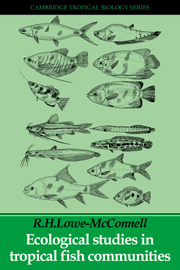Book contents
- Frontmatter
- Contents
- Preface
- Acknowledgements
- PART I INTRODUCTION
- PART II FRESHWATER STUDIES
- PART III MARINE FISH STUDIES
- PART IV SYNTHESES
- 11 Responses of fishes to conditions in tropical waters
- 12 Trophic interrelationships
- 13 Diversity: its maintenance and evolution
- 14 The exploitation and conservation of tropical fish stocks
- Appendix: Fish families in tropical waters
- References
- Index
12 - Trophic interrelationships
Published online by Cambridge University Press: 07 May 2010
- Frontmatter
- Contents
- Preface
- Acknowledgements
- PART I INTRODUCTION
- PART II FRESHWATER STUDIES
- PART III MARINE FISH STUDIES
- PART IV SYNTHESES
- 11 Responses of fishes to conditions in tropical waters
- 12 Trophic interrelationships
- 13 Diversity: its maintenance and evolution
- 14 The exploitation and conservation of tropical fish stocks
- Appendix: Fish families in tropical waters
- References
- Index
Summary
Trophic interrelationships and community structure
Although food webs in tropical waters are often very complex, they may be based on relatively few sources, for example the aufwuchs which supports numerous species on the rocky shores of Lake Malawi (Fig. 4.2), or the benthic algal flora that supports herbivorous fishes on marine reefs. In any food chain there are rarely more than four or five links; long chains are energetically expensive as a large proportion of the potential energy is lost at each successive stage. In freshwaters alternate chains run: (1) from bottom detritus, through microorganisms, to detritus–feeding invertebrates or fish, to several levels of piscivore; or (2) in the pelagic zone from phytoplankton to zooplankton, to zooplanktonfeeders, then to one or more levels of piscivore. In river systems the detrital chain is more important, based largely on allochthonous materials in the headwater streams while in lower reaches detritus comes mainly from decomposition of aquatic macrophytes (see the ‘river continuum concept’ of Vannote et al., 1980; but see also Rzoska, 1978). As a lake forms, the pelagic plankton chain becomes increasingly important, as seen after the filling of man–made lakes, and also in lakes such as Chad, populated with riverine fishes such as Alestes baremose which changed its riverine diet of insects and seeds to exploit zooplankton in the lake.
- Type
- Chapter
- Information
- Ecological Studies in Tropical Fish Communities , pp. 270 - 286Publisher: Cambridge University PressPrint publication year: 1987



